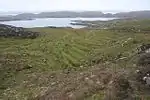Seaweed fertiliser
Seaweed fertiliser, also spelled seaweed fertilizer, is seaweed that is collected and used as an organic fertilizer.


Cultural history
In the Channel Islands, such seaweed fertiliser is known as vraic in their dialects of Norman, a word that has also entered Channel Island English, the activity of collecting vraic being termed vraicking. In Scotland, it is used as fertiliser in lazybeds or feannagan. Falkland Islanders have also been nicknamed "Kelpers" from time to time, from collecting seaweed partly for this purpose.[1] Dulse and kelp (Laminaria digitata) has been used as fertiliser on the west coast of Ireland since at least the 13th century.[2][3][4]
Fertilisers
Several of the 12,000+ varieties of seaweed in the ocean have been shown to be valuable additions to the organic garden and can be abundantly available free for those living near the coast. However, caution should be observed when collecting seaweed, particularly from areas that are liable to pollution, such as downriver (including estuaries) of industrial activities as seaweed is susceptible to contamination. There are also legal implications relating to gathering seaweed, and concerns about sustainability.[5] In terms of soil structure, seaweed does not add a great deal of bulk, but its jelly like alginate content helps to bind soil crumbs together, and it contains all soil nutrients (0.3% N, 0.1% P, 1.0% K, plus a full range of trace elements) and amino acids. For those who cannot gather fresh seaweed, it is available commercially in a dried 'meal' form or as a concentrated liquid extract which is active in significantly smaller rates. While 'meal' products are limited to soil applications due to their insolubility, foliar feeding or root zone applications through drip lines are possible with soluble extracts.
Composting
Seaweed, particularly bladderwrack, kelp or laminaria, can be either applied to the soil as a mulch (although it will tend to break down very quickly) or can be added to the compost heap, where it is an excellent activator.[6] A perhaps less serious potential problem with seaweed is its salt content. While it is unlikely to add sufficient seaweed to seriously upset the balances of salt in the soil, it is not liked by worms, who will not live in it. It can be hosed down before adding to the soil to reduce the salt content, or left to be desalinated by rainwater. Rinsing seaweed is risky as valuable alginates are potentially lost to runoff.
See also
References
- "The people of the Falklands". Stanford University. Retrieved 2009-05-19.
- Editors, Natural Knowledge (6 September 2012). "Seaweed: A Brief History". Natural Knowledge 24/7.CS1 maint: extra text: authors list (link)
- Galway, Lorna Siggins. "Sea change in the west: deal divides seaweed harvesters". The Irish Times.
- "Seaweed harvesting in Clare". www.askaboutireland.ie.
- "Seaweed products". Gardening Advice. Royal Horticultural Society. 2009-03-31. Retrieved 2009-05-19.
- Coleby-Williams, Jerry (2006-12-16). "Fact Sheet: Seaweed Fertiliser". Gardening Australia. ABC. Retrieved 2020-12-23.